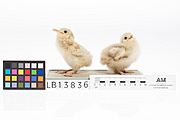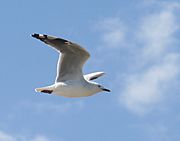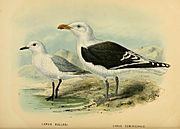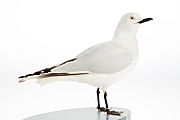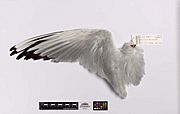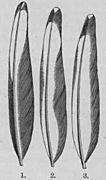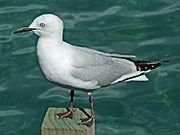Black-billed gull facts for kids
Quick facts for kids Black-billed gull |
|
|---|---|
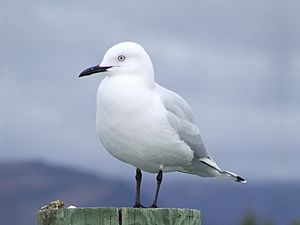 |
|
| Conservation status | |
| Scientific classification | |
| Genus: |
Chroicocephalus
|
| Species: |
bulleri
|
| Synonyms | |
|
Larus bulleri |
|
The black-billed gull (Chroicocephalus bulleri), also known as Buller's gull or tarāpuka (in Māori), is a special type of gull. It belongs to the Laridae family. This bird is only found in New Zealand. Its family came from Australia about 250,000 years ago. It is currently listed as a Near Threatened species, meaning it could become endangered soon.
Contents
Discovering the Black-billed Gull

The black-billed gull has had a few names over time. In 1855, a scientist named Carl Friedrich Bruch first named it Gavia pomare. But this name was already in use for another bird.
Later, Sir Walter Lawry Buller, a New Zealand bird expert, suggested a new name. He even used a playful name, Bruchigavia, which means "Bruch's seabird." However, his suggested species name, melanoryncha, was also already taken.
Finally, in 1871, Frederick Hutton suggested the name bulleri. This was to honor Sir Walter Buller. Buller accepted this name. This is why the bird is also called Buller's gull. Today, scientists place this gull in the Chroicocephalus group.
What Does the Black-billed Gull Look Like?
A grown-up black-billed gull is usually about 35–38 cm long. Its wings can spread out to 81–96 cm wide. It weighs around 230 grams, which is about the same as a can of soda.
Its head, body, and parts of its wings are white. The back and wings are silvery grey. The edges of its wings are black.
This gull's colors can change with the seasons. From February to June, the ring around its eye is usually black. For the rest of the year, it turns orange-red, red, or dark red. Its legs also change color. They go from black to dark red or even bright red during the breeding season. This might be because of the baby chicks.
It's easy to mix up the black-billed gull with the red-billed gull. But the black-billed gull has a black bill, as its name suggests. It also looks more delicate and flies more gracefully. It is generally quieter than the red-billed gull, even though their calls sound similar. Sometimes, black-billed gulls and red-billed gulls have babies together. These mixed-breed gulls have dark red bills.
How Black-billed Gulls Behave
Black-billed gulls live in groups called colonies. They often start nesting around the first pair that builds a nest. These colonies can be very crowded. Gulls are often so close that their nests touch. This leaves little room for them to take off and land.
Male gulls might act aggressively towards others in their space. But these fights are usually short. They use their bills to peck, wings to beat, and legs to scratch. The other gull usually leaves right away. Adult gulls rest at their breeding colony or where they find food. They usually prefer to rest near food sources.
Where Do Black-billed Gulls Live?

The black-billed gull only lives in New Zealand. Most of them, about 78%, live in the Southland area. This is at the southern end of the South Island.
During breeding season, you can find them near big rivers, especially braided rivers, lakes, and farms. When it's not breeding season, they usually prefer estuaries and coastal areas. However, some stay at their breeding spots all year.
These gulls are also drawn to cities. They like places where they can find food scraps, like rubbish dumps. In 2019, a colony of about 300 birds even started living in Christchurch Central City.
Sometimes, they are seen on Stewart Island and The Snares. They have also been seen high up in the mountains, at altitudes of up to 1700 meters above sea level.
There are also colonies on the North Island. They used to only visit there. The first time they were recorded breeding on the North Island was at Lake Rotorua in 1932. Some gulls from the South Island fly across the Cook Strait to spend winter in the North Island after breeding season.
Important Bird Areas
BirdLife International has found several places that are very important for protecting black-billed gulls.
|
|
Are Black-billed Gulls in Danger?
Black-billed gulls are facing a tough time. In the 1970s, there were about 140,000 breeding birds in Southland. But recent counts show only 15,000 to 40,000 breeding birds. This means their numbers have dropped a lot.
Because of this fast decline, the IUCN has listed the species as Near Threatened. This means they are close to becoming endangered. The New Zealand Department of Conservation even listed them as Nationally Critical in 2016. Some people call the black-billed gull "the world’s rarest gull."
What Threatens Black-billed Gulls?
The biggest danger to young black-billed gulls is predators. About 80% of chick deaths are caused by other animals. Animals brought to New Zealand, like ferrets, stoats, cats, and hedgehogs, are a big problem. They eat the chicks and eggs. Native birds like the black-backed gull also prey on black-billed gull chicks.
Even though black-billed gulls can handle some human activity, people have also harmed them. Large shootings of gulls, like one in 2009 where about 200 birds were killed, are very damaging. There have been other similar events. Some people even drive vehicles through gull colonies. This might happen because people confuse them with the more common red-billed gull, which is also endangered in New Zealand.
Past use of chemicals like DDT on farms might have affected the gulls' ability to breed. Also, chemicals still used today could have unknown effects.
Climate change could affect black-billed gulls in different ways. It might help them by allowing longer breeding seasons. But it could also cause problems, like making food harder to find at the right times.
Nesting on river islands also makes chicks vulnerable to floods. In January 2018, one colony lost up to 2500 chicks in a flood. Another colony lost about 2200 eggs in a flood later that year.
How Are We Helping Black-billed Gulls?
People are working to protect the black-billed gull. In October 2018, the Department of Conservation started a trial to control black-backed gulls along the Hurunui River. This was to stop them from eating black-billed gull chicks. The trial was successful.
In August 2019, a five-year program began. It aims to reduce the black-backed gull population in certain areas by at least 80%. This will help black-billed gulls and other threatened birds.
The black-billed gull also got some attention in the Forest & Bird's 2018 Bird of the Year competition. It placed 30th with 441 votes.
Gallery
See also
 In Spanish: Gaviota maorí para niños
In Spanish: Gaviota maorí para niños



